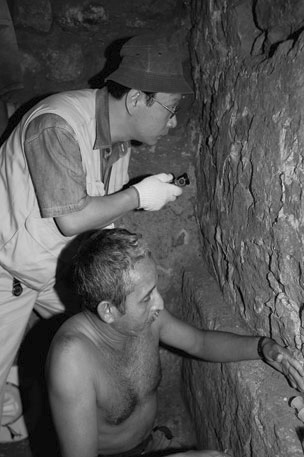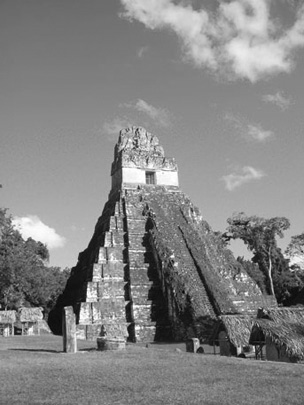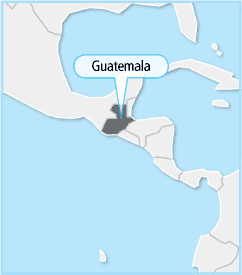Japan's Official Development Assistance White Paper 2010
Column 11 Preserving World Heritages on
the relation of Trust
— Cooperation for the Preservation
of Tikal Ruins in Guatemala —
”The Land of Everlasting Spring,” Guatemala has a temperate climate. In the northern area of the continuous expansion of lush jungle, the remains in Tikal, the largest city of the Mayan civilization flourishing from 3rd century to 9th century A.D. suddenly appear. The temples, sculptures, and other ruins have an important value for the history of humankind, and they are the preeminent tourism resources of Guatemala which attract many tourists. At the same time, however, their preservation and restoration became a challenge.
Japan has provided cultural grant assistance since 2010 for the construction of facilities and provision of equipment to preserve and restore the cultural properties of the Tikal ruins (*1).
Professor Seiichi Nakamura of Cyber University plays a role in this project. Professor Nakamura was fascinated by the Mayan civilization when he was a high school student, and majored in archaeology at Kanazawa University. After graduating from the university, pursuing his interest in the Mayan ruins, he got involved in an excavation study in Honduras as a Japan Overseas Cooperation Volunteer (JOCV). Today, he still continues to work with the Mayan ruins.
Professor Nakamura, because he is a faculty member of the university, is not based in Guatemala and goes back and forth between the two countries to carry out his activities. For the construction of center for conservation and research, which is the goal of the project, he attends meetings of the Ministry of Culture and Sport of Guatemala and visits with the project manager at the Tikal National Park where the ruins are. At the sites within the Park, Professor Nakamura observes the excavation and restoration work, and gives advice based on archaeology. In addition, he provides support for the smooth implementation of the entire project.
The Tikal ruins are inscribed as a UNESCO World Heritage Site (*2). In providing assistance for their preservation, Professor Nakamura always keeps an important point in mind. ”First and foremost, the ruins are a treasure of Guatemala and the local communities, before they are a World Heritage Site. So for a foreigner to take part in a project that is important to the Guatemalan people, you must obtain their trust, then they are sure to count on you.” — Professor Nakamura explains the importance of establishing trust with the people of the country.
Professor Nakamura, who leads a busy schedule, faces difficulties he has to struggle with occasionally in ensuring the continuance of the project . Because there are frequent changes in the project head on the Guatemalan side, he must start all over again in explaining about the project to the new one, so that he/she can understand it. He said, ”To go forward with a project, you have to be persistent in explanations to your counterpart.”
The ruins of the Mayan civilization are extended over five countries: Mexico, Guatemala, Belize, Honduras, and El Salvador. The people of these countries are proud of the Mayan ruins in their own respective country. However, if the feeling that their own country’s cultural properties are number one becomes too strong, the exchanges on the Mayan ruins may not go well. Professor Nakamura said, ”It is under such situations that a Japanese person like myself goes in the middle and can give new life to the exchanges. I believe they are given very favorable opportunities for exchanging each others’ knowledge, skills, and experiences, for the common goal of preserving the Mayan ruins.” In this way, he described the significance of the involvement of foreigners with specialized knowledge.
In Tikal, where diverse nature and valuable civilization coexist, the project, as of 2010, is proceeding smoothly and is being developed. Guatemalans fully understand the importance of the project, and despite economic limitations, they are trying to preserve the ruins and cultural properties as much as possible. Regarding the establishment of the conservation and research centre, Professor Nakamura explains his future dream, ”This project is the first step to cooperate for supporting the efforts of the Guatemalan people. In the future, with the conservation and research centre as the base, and with the cooperation of Japanese universities and academic institutions, I would like to explore possibilities for conducting exchanges between students and professors in Tikal as well as international joint research on the Mayan ruins.”
*1 Project for construction of the Center for Conservation and Research of Cultural Heritage in Tikal National Park
*2 Tikal National Park is a mixed property, which has value both as a cultural property and natural property.

Providing assistance at the excavation site (left, Professor Nakamura) (Photo: Professor Nakamura)

Pyramid in Tikal (Photo: Professor Nakamura)

